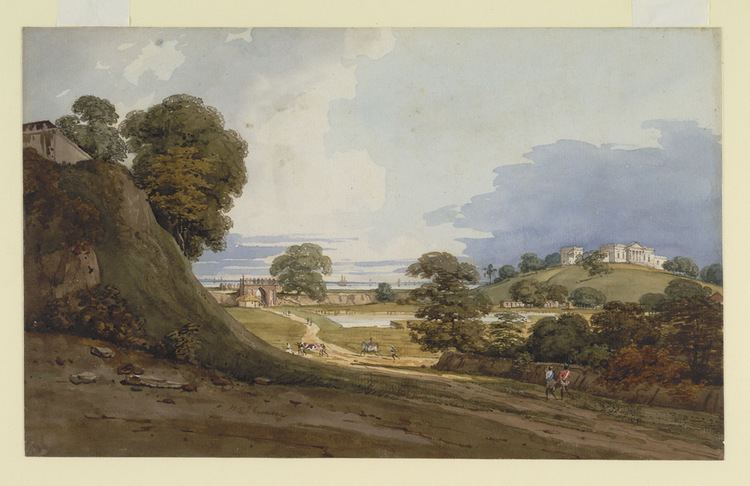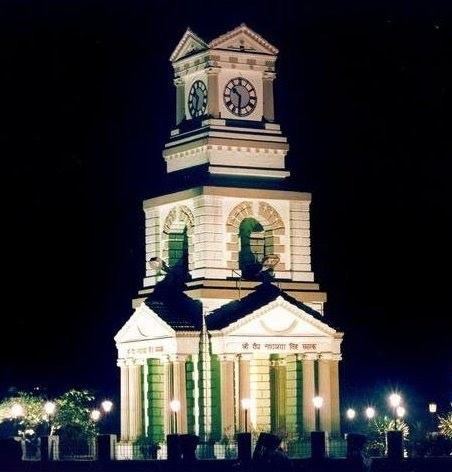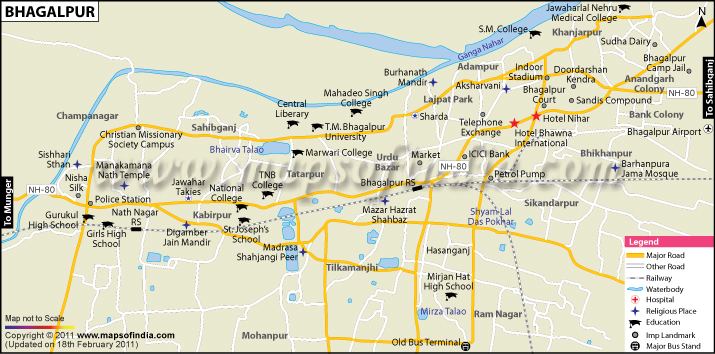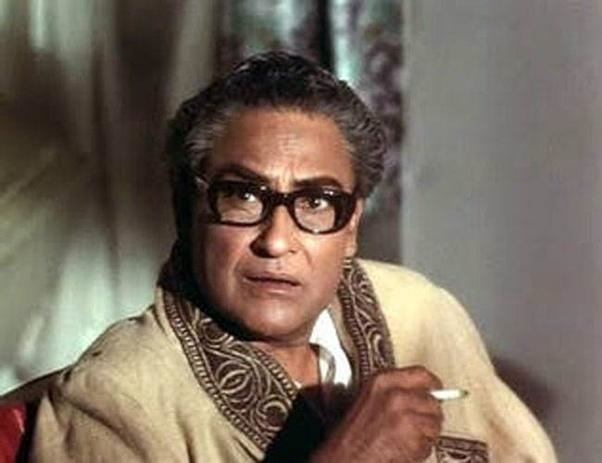Country Area 110 km2 District Bhagalpur | ||
 | ||
Colleges and Universities Tilka Manjhi Bhagalpur University, Vikramshila, Bhagalpur College of Engineering | ||
Map of Bhagalpur
Bhagalpur is a city of historical importance on the southern banks of the river Ganges in the Indian state of Bihar. It is the 3rd largest city of Bihar and also the headquarters of Bhagalpur district and Bhagalpur division. Known as Silk City, it is a major educational, commercial, and political centre, and listed for development under the Smart City program, a joint venture between Government and industry. The Gangetic plains surrounding the city are very fertile and the main crops include rice, wheat, maize, barley, and oilseeds. The river is home to the Gangetic dolphin, the National Aquatic Animal of India, and the Vikramshila Gangetic Dolphin Sanctuary is established near the town.
Contents
- Map of Bhagalpur
- Bhagalpur india driving through the city with a gopro
- History
- Economy
- Industry
- Education
- Smart City proposal
- Demography
- Vikramshila Gangetic Dolphin Sanctuary
- Garuda greater adjutant
- Vikrasmshila Mahavidyalaya
- Mandar Parvat Hill
- Kuppa Ghat
- Ajgaivinath Temple Sultanganj
- Budhanath Temple
- Shri Champapur Digamber Jain Temple
- Khanqah e Shahbazia
- Transport
- Media
- Notable people from Bhagalpur
- References

Bhagalpur india driving through the city with a gopro
History
The name Bhagalpur is etymologically derived from Bhagdatpuram (meaning city of Good Luck), as it was called during the flourishing period of the Anga Kingdom. Bhagdatpuram, as per Hindu mythological texts, was the place where the gods (devtas) and demons (asuras) churned the ocean to procure elixir (amrit). It is believed that the serpent, Vasuki, offered to serve as the rope for the churning. An impression of the coil is faintly visible on Mount Mandara, a granite hill situated along the national highway between Bhagalpur and Dumka. It is believed that Panchjanya, the conch shell used in the Mahabharata was discovered here in the "Shankh Kund". The Puranas also refer to this hill. It is said that Vishnu covered the demon Madhu under the hill after defeating him to death.
Kalidasa's Kumarasambhava refers to the foot marks of Vishnu on the slopes of Mount Mandara. The hill is replete with relics of bygone ages. Apart from inscriptions and statues, there are numerous rock cut sculptures depicting various images of Hindu Gods. The hill is equally revered by the Jains who believe that their 12th Tirthankara attained nirvana at the summit. The area around Mandara Hill is laced with a landscape of extraordinary splendour. The 800 feet high granite hill is a sight to see during daylight. It is a popular picnic spot for people living in the area.

References to Bhagalpur can be found in Hindu epics like the Ramayana and the Mahabharata where Bhagalpur has been described as the kingdom of Anga. Ancient cave sculptures from Emperor Ashoka's reign, from 274 to 232 BC are found in the neighbourhood and at Sultangunj, 20 km west of Bhagalpur, a temple from the Gupta period still exists in Bhagalpur. The tomb of Suja, brother of Moghul emperor Aurangzeb, in the heart of the town is reminiscent of the town's association with the Mughal period.
The city was referred to as one of the largest trading centres in India by the 7th century Chinese travellers Xuanzang and Faxian. At that time the city had a large harbour at Champanagar, now known as Champanala on the Ganges which flows through the western boundary of the present city near Nathnagar. Many boats and coins of the Middle and Far East were collected during archaeological excavations carried out during the 1970s.

The ruins of ancient Vikramashila Mahavihara are located 44 km east of Bhagalpur. The royal university ranks next to Nalanda, and owes its origin to Dharmapala, the devout Pala king who called himself Paramasaugata (chief worshipper of the Buddha) and was a great patron of Mahayana Buddhism. It was the medieval centre for the conservation and propagation of Buddhist education, established at the end of the 8th century.
Bhagalpur formed a part of the ancient Sanskrit kingdom of Anga, said to be ruled by king Karna of Mahabharata who was well known for his charity. In later times it was included in the powerful Hindu kingdom of Magadha, or Behar, and in the 7th century it was an independent state, with the city of Champa as its capital. Afterwards it formed a part of the Mohammedan Kingdom of Gaur, West Bengal, and was subsequently subjugated by Akbar, who declared it to be a part of the Delhi empire. Bhagalpur passed to the East India Company by the grant of the emperor Shah Alam II in 1765. Bhagalpur was one of the most important trade centres in Bengal Presidency during the British rule in India.
A notable event in 1989 were the clashes between Muslims and Hindus which left more than 1000 dead, mostly Muslims 1989 Bhagalpur violence. The violence was ignited after a Hindu religious procession came under bomb attack.
Over the next few weeks, organised mobs of thousands would burn over 250 villages down, and mass killings would take place across the district. The 1995 Riots Inquiry Commission Report by Justices Ram Chandra Prasad Sinha and S Shamsul Hasan blamed the administration, the press and the police for disseminating false information in an already communalised situation.
Economy
Bhagalpur has been associated with the silk industry for hundreds of years, and famous all over India for its Tussar Silk & Bhagalpuri Saree. Silkworms are employed to produce the renowned Tussar Silk from which Tussar Saree is manufactured. The Silk Institute and Agricultural University are located in the city. However, due to the industrial revolution, large portions of the silk business, based on the handloom were affected. Total revival of this industry is needed to regain expertise in this area, sadly neglected by successive governments.
Industry
The thermal power plant at NTPC Kahalgaon in Kahalgaon falls under Bhagalpur district. The largest industrial belt of the district is Barari industrial Area, with Kahalgaon industrial Area being equally important. The Government of India has established a Hand-loom park. A food park has been established by private entrepreneurs.
Education
Smart City proposal
This is an ambitious project which has no firm start date. The company which drafted the proposal, Ecroys India Private Limited, is keen to start, but funds are slow in coming. The proposal focussed on a 19-point agenda. These included:
Demography
As of the 2011 India census, Bhagalpur town has a population of 410,210, while the district as a whole has a population of 3 million. It is the 3rd largest city in Bihar in terms of urban population. Males constitute 54% of the population and females 46%. Bhagalpur has an average literacy rate of 81.16%, while the male literacy rate is 85.38% with women at 76.31%.
Vikramshila Gangetic Dolphin Sanctuary
Vikramshila Gangetic Dolphin Sanctuary is famous for Gangetic dolphins, locally called as sonse. The Vikramshila Gangetic Dolphin Sanctuary was established to protect the endangered Gangetic dolphins. This is the only sanctuary in Asia for the conservation of Gangetic dolphins.
Once found easily in Ganga, today only 1500 Gangetic dolphins are left in the world. Half of them can be found at the Vikramshila Gangetic Dolphin Sanctuary.
The sanctuary is a 50 km stretch of the river Ganga from Sultanganj to Kahalgaon. Gangetic dolphins are the major attraction of the sanctuary. Vikramshila is one of the few dolphin tourism spots in India. Take the boat ride in the 50 km stretch of the Vikramshila sanctuary and you will definitely come across several Gangetic dolphins in the region. For dolphin sightings the best time to visit Vikramshila Sanctuary is June and October. There is other wildlife at the Vikramshila. several species of freshwater turtles, waterfowl, otter and Gavialis gangeticus.
Garuda (greater adjutant)
World's Second Largest Rescue and Rehabilitation Area for Garuda is Bhagalpur. In Indian mythology, Garuda is considered the vahana or carrier of the god Vishnu. The mythical Garuda is staging a comeback - only this time in reality. Four years after these endangered birds of the stork family started nesting and breeding in Bhagalpur district, their number has increased over sixfold - from 78 to over 500. Worldwide its population is about 1200-1300. They live in only three places; one is Cambodia and other two are in India. In Cambodia, the garuda population is about 150, in Assam the garuda population is about 650, and in the Bhagalpur district (around Kadwa Diyara, a place nearby Naugachia) the garuda population is about 500.
Loss of nesting habitat and feeding sites through drainage, pollution and disturbance, together with hunting and egg collection, caused a massive dip in the population of the species. First spotted the Garuda birds nesting and breeding in 2007 on a silk cotton tree near a village in the Ganga-Diara area in Bhagalpur. In May 2006, 42 birds were seen by the Mandar Nature Club team for the first time. Prior to this, the species had never been seen in Bihar during its breeding period.
The garuda, biologically known as greater adjutant (Leptoptilos dubius), is classified as endangered on the IUCN Red List 2004 of threatened species and listed under Schedule IV of the Indian Wildlife (Protection) Act, 1972. This huge stork has a naked pink head, a very thick yellow bill and a low-hanging neck pouch. The neck ruff is white. The bird looks like a vulture. Other than the pale grey edge on each wing, the rest of the greater adjutant's body is dark grey. Juveniles have a narrower bill, thicker down on the head and neck, and entirely dark wings. A Garuda bird measures 145–150 cm (about three feet) in length and four to five feet in height.
Vikrasmshila Mahavidyalaya
Vikramashila Mahavidyalaya, 38 km from Bhagalpur ranks next to Nalanda and owes its origin to Dharmapala (770-810 AD), the devout Pala king who loved to call himself Paramasaugata (chief worshipper of the Buddha)and was a great patron of Mahayana Buddhism. Dharmapala was impressed by two things which prompted him to establish Vikramshila. Firstly, the rocky hillock anchored around the confluence of Kosi and Ganga at Vateshwarasthan was not only a scenic attraction but a popular tantric site as evident from the presence of a Kali temple (instead of Parvati's) in front of Shiva temple, besides various other caves and rock cut sculptures dating back to the 6th or 7th century AD. Secondly, the place was associated with pilgrimage due to Uttarvahini Ganga which drew large crowds during Varsavardhana. Unlike Nalanda, sources of information on Vikramashila is confined to Tibetan texts and they make us believe that Dharmapala in his earlier birth was an accomplished acharya, Kampilya, who had attained siddhi or perfection in Mahayana mudra mysticism here and was determined to build a monastery one day.
Mandar Parvat (Hill)
Mandar Parvat (Hill) is roughly 700 feet high. It is situated about 30 miles south of the Bhagalpur town in Bihar. There is an eastern railway line connecting Bhagalpur with Mandar Hill. Mandar Hill station is about three miles from Mandar Hill. There is also an all- weather road that connects Bhagalpur with Dumka.
Amrit Manthana or Samudra manthan which suggests that the hill was used by the gods to churn the ocean to procure amrit. The serpent, Basukinaga offered to serve as the rope and has left behind an impression of the coil on the granite hill. It is believed that panchjanya, the conch shell used in Mahabharat War, was discovered here in the Sank kund.
The puranas refer to various sacred places on the hill which is also believed to be the abode of Vishnu under the title of Madhusudana or the destroyer of a demon called Madhu who was killed by Vishnu and then covered by the Mandar hill. Kalidasa's Kumārasambhava refers to foot prints of Vishnu on the slopes of Mandar. Besides inscriptions and statues, there are numerous rock cut sculptures depicting various Brahmanical images.
The hill is equally revered by the Jains who believe that their 12th Tirthankara attained nirvana here on the summit of the hill.
At the salvation place on Mandar Hill, a grand Jain Mandar Hill Temple is erected. A pair of feet images (about 3000 years old) are installed there. There is a place where Lord Vasupujya attained Kevalgyan (supernatural knowledge) near the place of salvation. Three pairs of ancient feet images are installed here. Near the place of salvation, a beautiful cave temple is viewable with a 5-foot-tall standing idol.
Kuppa Ghat
The word 'Kuppa' means a tunnel or cave, and "Ghat" means place located on a river-bank. Accordingly, there is a cave at Kuppaghat which has been rendered famous and immortalised by Maharshi Mehi Paramhans, the legendary exponent of Santmat.Kuppa Ghat is a place located on the banks of the holy river Ganges at Bhagalpur, Bihar, India. Maharshi Mehi Ashram, Kuppaghat, Bhagalpur has, over the years, grown into a sacred pilgrimage for millions of followers of Santmat from India and abroad. The auspicious occasions of the birth anniversary of Maharshi Mehi Paramhans and Maharshi Santsevi Paramhans, the successor of Maharshi Mehi, who also made this ashram his main camp and residence, and Guru Purnima the ashram draw lakhs of devotees presenting a celebratory environment impregnated with piety. Maharshi Mehi practised surat shabd yoga or the Yoga of Inner Sound for several months here in this cave and later constructed his ashram also; several yogis or spiritual aspirants can still be seen practising the Yoga of Inner Light & Sound in this dark cave completely insulated from the din & bustle and brightness of the outside world.
Maharshi Mehi Ashram blossomed under his dynamic leadership to become the national headquarters of Akhil Bharatiya Santmat-Satsang. It has an aesthetically laid out garden and orchard beautifully punctuated with sculptures, paintings and quotes having spiritual significance like a cottage showing Lord Rama visiting great female devotee Shabri and killing of Jatayu, the vulture, at the hands of the demon king Ravana.
According to some unconfirmed accounts, Lord Gautama Buddha is also said to have lived in this cave in one of his previous births.
Maharshi Mehi Ashram, Kuppaghat, Bhagalpur has, over the years, grown into a sacred pilgrimage for millions of followers of Santmat from India and abroad. The auspicious occasions of the birth anniversary of Maharshi Mehi Paramhans and Maharshi Santsevi Paramhans, the successor of Maharshi Mehi, who also made this ashram his main camp and residence, and Guru Purnima the ashram draw lakhs of devotees presenting a celebratory environment impregnated with piety.
Ajgaivinath Temple Sultanganj
Ajgaivinath Temple is the one of the famous Indian Hindu Temple dedicated to Lord Shiva situated in Sultanganj. It is believed that the deity of the temple is Swayambhu. Sultanganj is a place of great antiquity. It has been traditionally associated with Jahnu sage, whose ashram was a centre of learning and culture. Muni Ashram Jahnu in the rock protruding into the bed of the Ganges. Now the site has Ajgaivinath Shiva temple, also known as Gaibinath Mahadeo. The story is that of the Ganges on their way to the ocean in the Muni hismeditation interrupted by the fever of its currents. The wise man swallowed the river in one stroke. Bhagiratha Muni intervened and once again let her out by making an incision in the thigh. That is why the Ganges also called Jahnavi.
Sultanganj traditionally been part of a large state Anga. On the Day of the Mahabharata, Karna, the brother of the sixth five Pandavas, ruled Anga. The capital of Anga was Champa. This Champanagar Champa is located three miles west of Bhagalpur. King Karna had castles at Champa (currently Champanagar) and Jahnugiri (modern Sultanganj). Currently Champanagar, Karna the castle site, is well known as Karnagarh. Karnagarh is practically part of the town of Bhagalpur.
Budhanath Temple
Spread over three acres Budhanath temple is located on the banks of the Uttarvahini Ganga (flowing from south to north) River. Being one of the oldest temple in the region it witnesses in flux of devotees throughout the year. It is about twenty minutes from the main town. Reference of Baba Budhanath can be found in Shiva Purana as Baba Bal Vridheshwarnath. Also, this name has been stated in the first segment of the eighth segments of Shiva Purana. The lingam of this place of worship is self-incarnated nevertheless as to when it come into being is still unknown. Idol of Ma Bhavani can be seen beside the Shivalinga or Lingam.
Shri Champapur Digamber Jain Temple
Champapur is an ancient and historic Teerth Kshetra of Jainsim. Champapur is the place where all the five Kalyanaks i.e., Garbha, Janam, Tapa, KevalGyan and Moksha Kalyanak of Bhagwan Vasupujya, the 12th Jain Teerthankar, have taken place. The Champapur was the capital of ‘Anga Janpada’. The Anga Janpada was one of the 52 Janapada established by Adi Teerthankar Bhagwan Rishabh Deo. Champapur also existed as Mahajanapada among the six Mahajanapadas during the time of Bhagwan Mahavira Swami.
The three Chaturmas of Bhagwan Mahavira Swami during his Dikshakal, religious propagation centre of Anga-Banga-Magadh-Vaishali, test of modesty of Sati Subhadra and Anantmati, Aahardan to Bhagwan Mahaveer Swami by Sati Chandan Bala have taken place in Champapur. Champapur is also related to great stories of ‘origin of Harivansha, Shripal-Mainasundari, Shri Dharma Ghosh Muni, King Karna of Mahabharata, King Mudrak and great architect Vishvakarman’.
The main temple of Champapur Siddha Kshetra is quite ancient (about 2500 years). This temple being symbolic of ‘Panch Kalyanaka’ is adorned with 5 altars, magnificent spire and 2 columns of fame. It is said that there were 4 ‘Columns of Fame (Keerti Stambha)’ which existed in four corners of the campus of the temple. Later on the 2 out of 4 were destroyed in the earthquake of year 1934 & repair (Jirnoddhar) of other 2 columns was done in 1938. The ‘Columns of Fame’ are about 2200 years ancient. In 2014, the tallest statue of Bhagwan Vasupujya was built and donated by Smt Sona Devi Sethi Charitable Trust based at Dimapur, Nagaland. The statue is 31 feet in height and the stone for the statue was brought all the way for Karnataka. The Panch Kalyanak Pratishtha Mahotsav of the statue was done from 27 February 2014 to 3 March 2014. Hundreds of thousands of Jain devotees from all across the world come and visit Champapur throughout the year. This majestic addition to the Champapur Digambar Jain Temple is attracting visitors from other beliefs as well.
Khanqah e Shahbazia
The world renowned Khanqah e Shahbazia is situated in Maulanachak locality near Bhagalpur railway station. Every Thursday there is a mass congregation of people from all faiths to request spiritual blessings. Visitors mainly come from the eastern part of India and from neighbouring countries including Bangladesh. This mosque was built by Mughal emperor Aurangzeb and was often visited by the emperor to get blessings from the Sufi shrine of Shahbaz Rahmuttallah. Shahbaz Rahmuttallah was considered one of the sacred 40 Sufis who was sent to spread the message of Allah to the masses. He is often considered sacred as per Barelvi sect of Islam. Also water content of the inside pond from this mosque has some medicinal benefits as per believer, especially as a cure from snake bite. Also it is good to be stated that Archaeological Survey of India has found some valuable manuscripts from the basement of this Khanqah dating back to the Mughal era. The gaddinashin of this khanqah often guides local masses on various issues and has a privilege of wide acceptance and spiritual influence throughout the area. He has a special privilege that he will never be booked in any case as per the law of land.
Transport
Bhagalpur city has approximately 200 km of roads. The transport system is good with, Auto, Taxi and cycle rickshaw easily available. In the city area around 10,000 autos, 500 private taxis and 200 buses are on the road. Bhagalpur is well connected to major cties of Patna, Kolkata, Ranchi, Jamshedpur, Munger, Gaya...etc. by various National Highway and State Highways.
Bhagalpur Junction railway station is situated on the Khana- Quil loop line which serves Bhagalpur with numerous trains. It is the 3rd busiest line in Bihar. About 40 pair Express and 10 pair passenger train go from this line. Bhagalpur Junction is A1 grade Railway station. It is the Highest revenue earner in the Malda Rail Division and third major railway station of Eastern Railway after Howrah and Sealdah. Bhagalpur is well connected with Delhi, Mumbai, Kolkata, Hyderabad, Bangalore, Ajmer, Kanpur, Patna, Guwahati, Surat, and Munger and other cities. In the Rail Budget of 2008, Bhagalpur was upgraded as a Railway Division. New rail lines are under construction, from Sultanganj to Deoghar, Bhagalpur to Dumka, Bhagalpur- Godda via Hanshdiya, and Banka to Deoghar. It is also the originating station for many superfast and express trains. The number of platform was increased from 3 to 6.
Media
Print media include the Hindi Dainik Jagran, Dainik Bhaskar, Aaj, Hindustan ( under Hindustan Times ) and Prabhat Khabar,, while English Times Of India, The Telegraph and Hindustan Times are also available.
Broadcast media include All India Radio (Frequency 1458 kHz, 1206 kHz) 90.4 FM Radio Active (Bhagalpur), and AIR FM Rainbow India 100.1.M,sadhna plus news channel
Telecommunications services include BSNL, Airtel, Aircel, Reliance, Vodafone, Idea, Reliance Communications, Uninor, Reliance India Mobile(RIM).
Jyo-fi Broadband Services (9430212648), BSNL and Sify are providing broadband services in this region.
